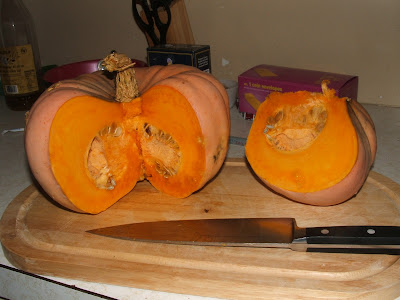I got a fun new kitchen toy for my birthday this year!
This happens to be a food strainer, specifically a Roma Food Strainer and Sauce Maker . This type of gadget is often referred to as a Squeezo
. This type of gadget is often referred to as a Squeezo (although that is technically the brand name for a particular, and very very expensive, food strainer). Squeezos can be used to make spaghetti sauce, salsa, mashed potatoes, vegetable or fruit purees, jams, and juices. Since I do a lot of canning, a Squeezo is very handy.
(although that is technically the brand name for a particular, and very very expensive, food strainer). Squeezos can be used to make spaghetti sauce, salsa, mashed potatoes, vegetable or fruit purees, jams, and juices. Since I do a lot of canning, a Squeezo is very handy.
Today I made pumpkin puree from one of my jarrahdale pumpkins. Over the course of about 24 hours, this particular pumpkin started to go soft and mushy, so I cooked it up as soon as possible.
 |
| My green jarrahdale pumpkin turned orange. Time to make puree! |
I removed the seeds and stem from the pumpkin, but left the stringy pumpkin guts and skin intact. After chopping into large chunks, the pumpkin was boiled until very soft. I strained and cooled the pumpkin slightly (part of my Squeezo are made from plastic, so I don't want them to melt). Then the pumpkin chunks went into the Squeezo. I was pleasantly surprised at how quickly and easily the process went. The strainer removes all the skins and stringy bits from the pumpkin and send them out a separate chute.
 |
| Boiling pumpkin |
 |
| Food strainer at work (the skins and waste comes out the chute on the left hand side of the photo). |
Overall, one jarrahdale pumpkin produced almost exactly 4 pounds of puree. I froze the puree in 2 cup (1 pound) portions. I have three more of these pumpkins, so eventually I'll have 16 pounds of puree! I look forward to making a variety of pumpkin-laden baked goods and maybe some pumpkin soup.
 |
| Left: pumpkin puree; Right: pumpkin waste |
One of my favorite recipes is pumpkin chocolate chip cookies. They are very moist and cakey. These cookies are especially good when made with dark chocolate chips and lots of cinnamon. More on these cookies in the future.
P.S. The standard screen that comes with the machine is supposed to be for applesauce and tomatoes, but it worked just fine for pumpkin. You can purchase extra screens designed for pumpkin, berries, salsa, and grape juice. I have a feeling that the standard screen will work for just about all of these (with the exception of grape juice of course). I'll find out next year if the standard screen is small enough to remove berry seeds.
designed for pumpkin, berries, salsa, and grape juice. I have a feeling that the standard screen will work for just about all of these (with the exception of grape juice of course). I'll find out next year if the standard screen is small enough to remove berry seeds.



















